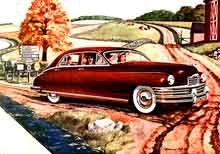Packard at the Crossroads
I first met Jim Schwantes in 2003, when he joined the Society of Automotive Historians. An enthusiast and collector of automotive advertising and art, Jim wondered about the 1948 Packard ad seen here, whether it represented an actual place or whether the location was entirely a creation of the artist.
The signpost tells us that the Packard is 2 miles from Milldale, 5 from Marion, 11 from Waterbury, 3 from Meriden and 12 miles from Middletown. Marion and Middletown might be anywhere: there are 19 Middletowns and 20 Marions in the United States. A bit less numerous are Meriden (5 in US) and Waterbury (only 3, though there are 8 Watertowns). "Milldale," however, struck a chord. I recognized it as a village in central Connecticut, not far from the CarPort's cyberportal. A glance at a Connecticut map confirmed my suspicions: all five locations lie within a twenty mile stretch of what would, in 1948, have been US Route 6A (now State Routes 322 and 66, interspersed with sections of Interstate 691).
I wondered if the artist, Australian-born Melbourne Brindle, might have lived near the area, as the legendary Peter Helck often painted scenes near his home in Boston Corners, New York. The location of the Packard is accurate, and represents a point on old 6A where two rutted dirt roads intersected the maine highway. The reader looks generally east, toward Meriden. Automobile Quarterly (Vol. 28 No. 3, Third Quarter 1990) published an article on Brindle, explaining that he lived for much of his working life in New Canaan and Bridgewater, Connecticut, and that many of his other works use local backgrounds.
Jim has recently lauched Vivipix, an enterprise marketing posters made from some 1,000 advertising images in his collection. This Packard ad is one of them, and they span the period 1937 to 1970. It is interesting to note the progression of Packard during this time, from the conservative 1937 cars to the decorous 1956 Caribbean. I consider Packard to have been at a crossroads in 1948, wondering whether to be a prestige car, or merely an upper-middle class on. This ad confirms their quandary, for it implies that the Packard Eight, the entry-level car, was the measure of the Custom Eight, which sold for more than twice as much. Unfortunately, they didn't look very much different, which might have been the problem.
Vivipix posters can be ordered on line; presently Packard and all GM marques, covering 1937 to 1970 are available. In some of them you will recognize artwork that appears in other installments of the CarPort.

